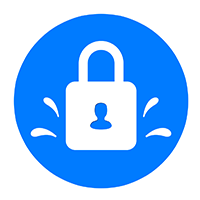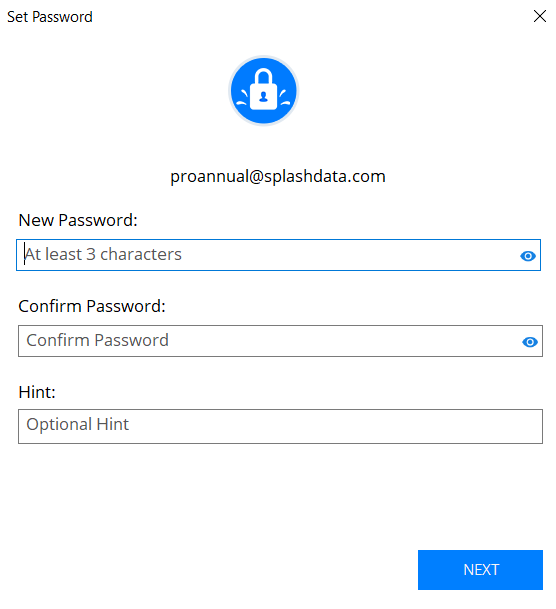Introduction
SplashID provides quick and easy access to all of your personal identification information, including usernames, passwords, credit cards, PINs, calling card numbers, frequent flyer numbers, insurance info, and more. Data is stored in a secure, encrypted, password protected format and can be synchronized between SplashID on your mobile device and SplashID on the desktop (Windows, macOS, and web). You may prefer to do most of your data entry on the desktop, however, since it’s faster and easier with a keyboard, and then synchronize that data to your other SplashID apps.
Please note our Windows Desktop app is recommended for use on Windows 10, though it can run on Windows Vista too. Windows XP is no longer supported.
Account Types
SplashID Safe is the only password manager that lets the user choose how to handle the storage of their sensitive records securely. You can choose between Cloud sync, local WiFi sync, or No sync based on your needs.
SplashID Cloud Services
SplashID Cloud Services provides seamless automatic sync across all your computers and devices via our secure cloud server: anywhere, anytime. It’s the quintessential “set it and forget it” sync solution for secure data.
In addition to automatic sync, the optional SplashID Cloud Services also includes a powerful web-based version of SplashID Safe, professional email support, and automated cloud backups.
Local Wi-Fi Sync Only
This is the familiar Wi-Fi sync solution that has been in SplashID since version 4. You can manually connect and sync SplashID on the mobile device with the PC or macOS desktop SplashID over your local Wi-Fi network.
No Sync Enabled
This option exists for those users who don’t plan on synchronizing their SplashID Safe data. Your data will exist only in the local database on the device, and will not be automatically backed up in the cloud or synchronized with any desktop or web app.
First Time Set Up
After SplashID is installed on your desktop and launched, it will need to be set up. The set up is very easy and follows a few steps to get you to start using SplashID.
After you enter your email address, SplashID will check with the server if the email address is registered. If the SplashID account exists, then it will ask you to enter your master password to complete the initial set up.
On the other hand, if the email isn’t found in the SplashID system, then you will be prompted to continue with registering a new SplashID account. The next section will explain the required steps needed for the registration.
Registration
Launch SplashID on your desktop and enter your email address to start creating your account. It is recommended that you use all lower case letters in your email address to prevent any confusion with your account email address. The screenshots below will show you the steps required to complete the registration process.
- Launch screen
- Email address entry
- Master password and password hint setup
After the master password and hint is accepted by the server, you will need to verify your email to activate your account. Please check your email inbox and click on the verification link to complete the user account setup.
Alternatively, you can choose to sign up for a new SplashID account on our website at https://www.splashid.com/register. This is the recommended sign up option for users in the EU region who need compliance with GDPR guidelines.
Login
You have the option to choose how you want to login to SplashID on your Windows desktop. Use your strong master password to sign in to the application for the first time after installing the app. Once set up, the master password is used to access your account and unlock the application.
- Master password
- Pattern unlock
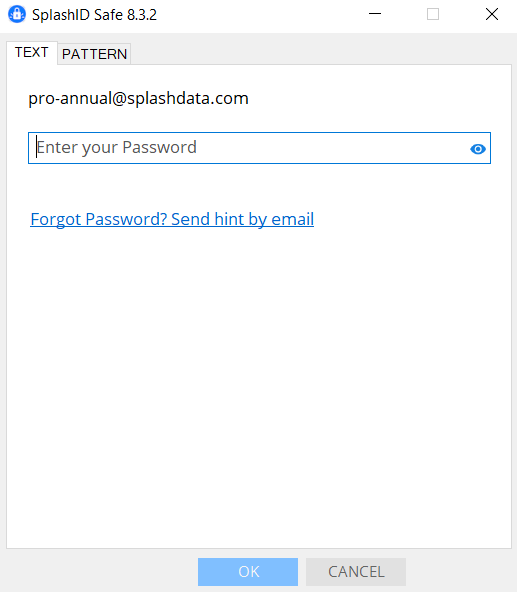
Cloud sync users can also access their records in their SplashID account on our website at https://www.splashid.com/login.
User Interface
When you sign in to SplashID on Windows you are presented with loading screen while the app is initializing, and then a 3-panel layout.
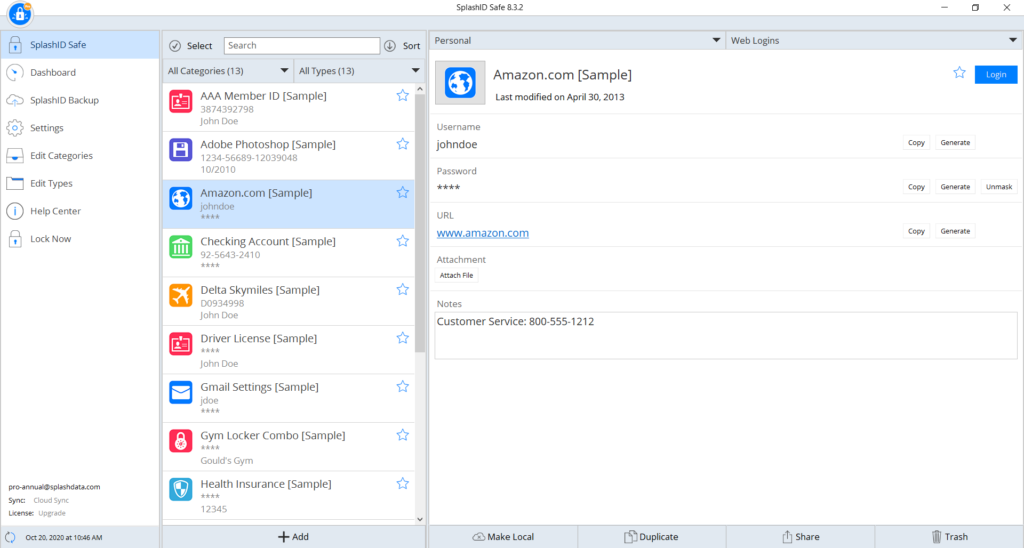
The width of the first and second panels in the layout can be adjusted to your liking by dragging the right side panel borders.
There is an Application menu that can be accessed by clicking on the SplashID Icon at the top.
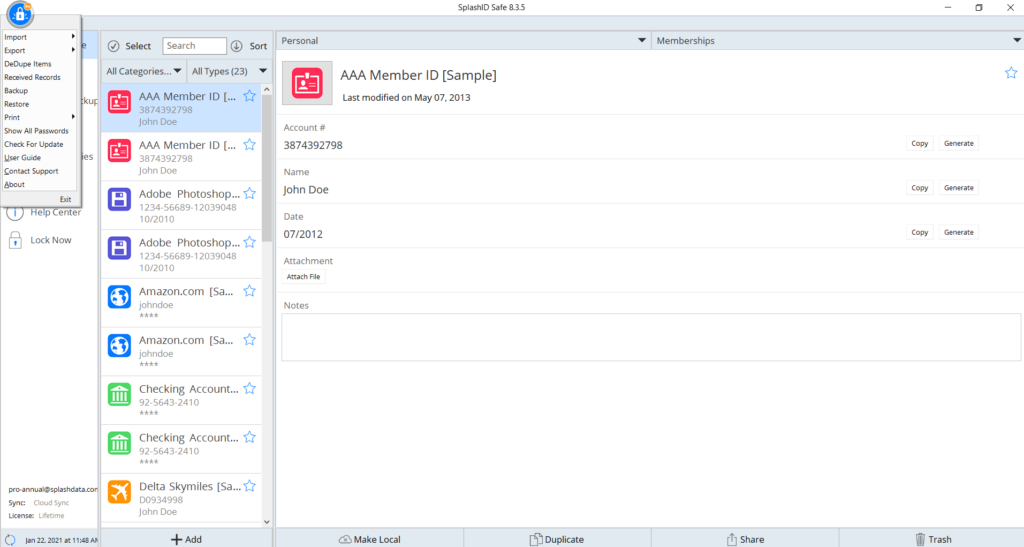
Here’s a breakdown of the different panels in the interface.
Side Menu
The Side Menu is similar to the side menu that slides out on the iOS and Android apps, and the fixed side menu of the Web app, where you can access the following options.
- SplashID Safe – This shows the Record List, where you search, view, and edit your secure records.
- Dashboard – Access the Dashboard, where you can analyze your records and improve your security.
- SplashID Backup – Cloud sync users will be able to access and restore online backups on those rainy days.
- Settings – Access all the SplashID Settings. See the next section for more details.
- Edit Categories – Displays the Categories which you may edit or delete. Select an existing Category and change its name or delete it via the Trash button, or click New to create a new Category.
- Edit Types – Displays the Types which you may edit or delete. Select an existing Type and change its name or field labels or delete it via the Trash button, or click New to create a new Type.
- Help Center – Access the SplashData Help Desk at https://support.splashdata.com to read our Knowledge Base, ask questions, submit a support ticket/etc.
- Lock Now – Locks and encrypts the SplashID database. You also can also make the Desktop app auto-lock after a certain amount of minutes.
Record List
The middle panel is known as the Record List. From here you will browse, search, add, edit, and view records. Starting from the top left, here are the functions of the Record List:
- Category and Type filters – Select a Category or Type to filter by, this includes Local only Category filter, which shows records that are set not to sync to Cloud/other apps (if any).
- Search – Search on any field with dynamic results
- Select – Brings up an action bar on the bottom of the screen so you can select multiple records to Share, Duplicate, Move to another Type or Category, or Delete
- Sort – Change the view to sort by Name, Type, Category, Modified Date, Most Visited, Added Date, or Viewed Date.
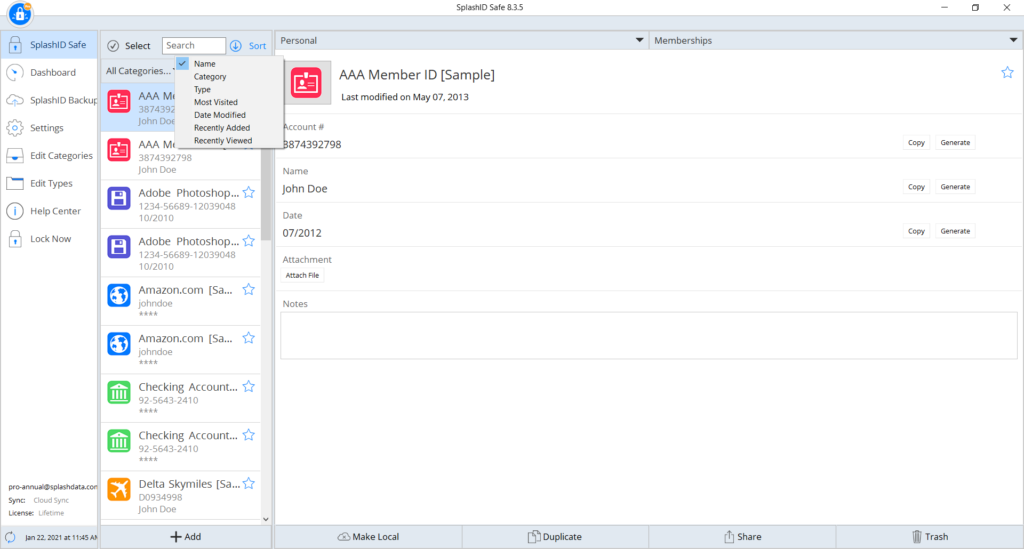
When you click on a record in the Record List, it opens the Record Details on the right panel.
Record Details
The right panel is for Record Details, which displays the details of the record you select in the Record List.
While viewing a record, click any field and then the Desktop app will go into Edit mode, so you can make changes. We’ve designed this screen to give you everything you need on one level so you don’t have to drill down to make changes. We’ll go into more detail in the Record Details and Editing Records sections below.
Application Menu
Access the Application menu (main menu) by clicking the SplashID icon in the top left.
- Import – Import SplashID SVID, vID files, CSV files, and other export formats from similar applications.
- Export – Export SplashID SVID, vID files for various versions as well as CSV plain text files that can be used for a number of applications.
- DeDupe Items – Searches for duplicate records and offers to delete them.
- Received Records – Shows the shared records you have received from another SplashID user if any.
- Print – Allows you to print one or more records.
- Show All passwords/Hide All passwords – Toggles between masking/unmasking of passwords for currently selected record in the details pane. You can also do the same via Ctrl+H on your keyboard.
- Check for Update – See if there is a newer version of SplashID Desktop available for download.
- Contact Support – This is a handy shortcut to take you to the SplashID support page on the web. You can fill out the form on the support page to get assistance from the technical support team.
- About – Displays version information, copyright info and links you to our Support Site.
SVID files support user uploaded icons on records and has enhanced user information to allow for updating the records during an import. You can manually export and import SVID files. It is recommended that you use SVID files instead of vID files during the manual export and import of records.
Record Details
When you click on a record in the Record List, it opens the Record Details screen. We’ve designed this screen to give you everything you need on one level so you don’t have to drill down to make changes.
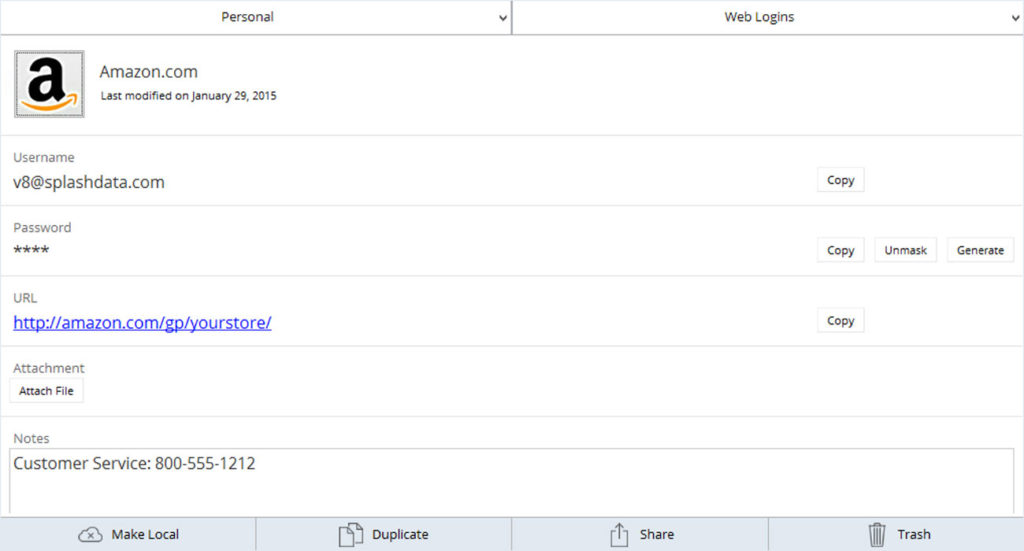
Click a field to access tools, such as Copy, Generate (password), and Mask, or also to edit the record’s data. You can set default password generator settings in the main Settings screen, or change them “on-the-fly”. If you want to add additional fields, click any existing field, then you can enter data into the extra fields/field names or add an attachment.
Click the Login button next to field 1 if the record is a Web Login to open your web browser and autofill the username and password. You can also turn on Auto-Submit in Settings.
Make Local will designate any record in your SplashID database as Local only. This means the record stays local on the desktop and does not sync to the Cloud server and your other SplashID Safe apps (if any). If the record is already on the web app or on any other devices running SplashID, it will get deleted from those apps. You can check for any such records via the Local only Category filter. If that shows no records, that means no records are set to Local only. At any point, you can set the record back to sync with the Cloud. The record would then sync back to the cloud server and appear on all devices and the web app.
Duplicate will make a copy of the current record so you can edit it and save it as a new record.
Share will send the record(s) as a secure file to other SplashID users or as a link to a limited use self-destructing web page for non-SplashID users.
Trash will delete the current record, after asking to confirm.
Editing Records
While viewing a record, click any field and then the Desktop app will go into Edit mode, so you can make changes. This is also what you see when you click the Add Record button in the top right. We’ve designed this screen to give you everything you need on one level so you don’t have to drill down to make changes.
Click the Category or Type menus to change the assigned category or type.
Click the icon to access the icon picker and make a new selection. This may not be necessary, however, as many logos are automatically assigned after you enter the record name. For example, type “Amazon” for the record name, and the Amazon logo shows up when you go to the next field or save.
Click the field in the data field space or the field label to edit it directly.
Click the Notes field to add notes up to 4000 characters.
Click the Attach File button near the bottom (you may need to scroll down to reach it) to add a photo or document (up to 1 MB per file and 1 attachment per record).
Categories & Types
Only Categories and Types that contain records are displayed in the filter menus on the Record List screen. So if you create a new Category/Type, it will not show up in the filter list until you create a new record and select the new Category/Type, and save the record.
The difference between Categories and Types is best illustrated by an example. You use Categories to separate your Business records from your Personal records, while you use Types to separate your Credit Card records from your Web Login records.
Categories act as filters for grouping related records. The two predefined Categories are Business and Personal, though you may add more by choosing Categories & Types from the left panel.
Types act as templates, which define the structure for the items you want to store in SplashID. You may define up to nine Custom field labels and a default icon for each type, as well as specify the fields you wish to mask or unmask.
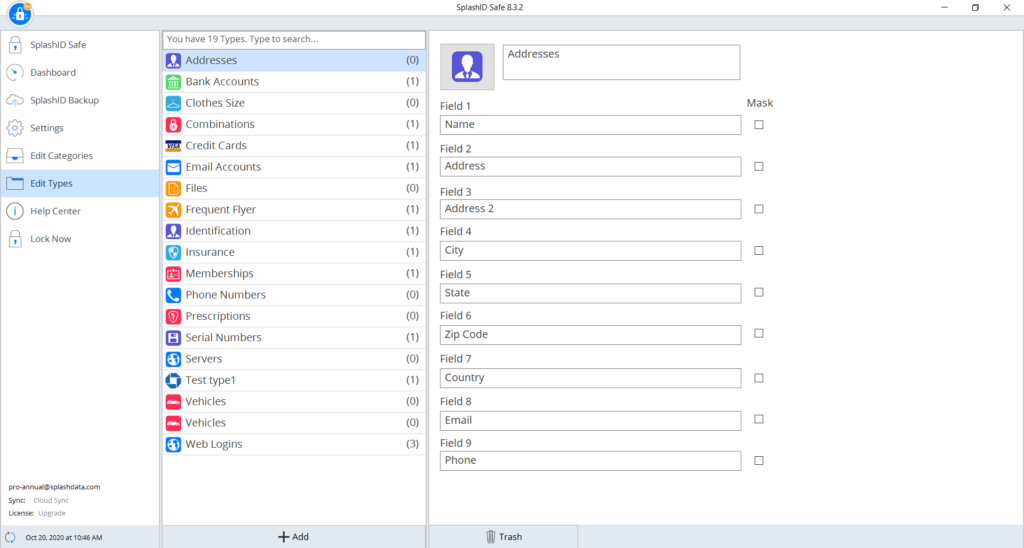
- Edit Types – Click the Edit Types button in the side menu on the left. You may create an unlimited number of Types. Several sample Types are provided, which you may edit or delete. Select an existing type and edit its fields/name/etc, or click + Type at the bottom of the middle panel to create a new one.
- Define Type – Enter a name for the new Type and up to 9 custom field labels. The Mask checkbox specifies whether or not the data in that field will be masked. And you may also specify a default icon for the Type.
Settings
Settings allow you to customize SplashID to fit your needs and to maintain your SplashID account. The sections below give a brief description of the available settings.
General Settings
The general settings screen for Cloud sync and WiFi sync user are shown below. The sections below will explain these settings in brief.
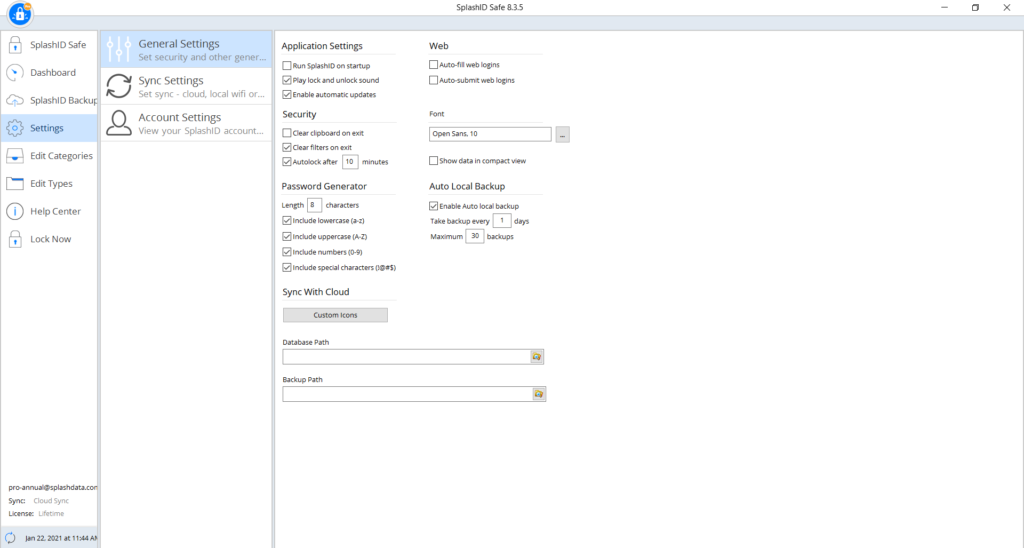
General settings for Cloud sync user
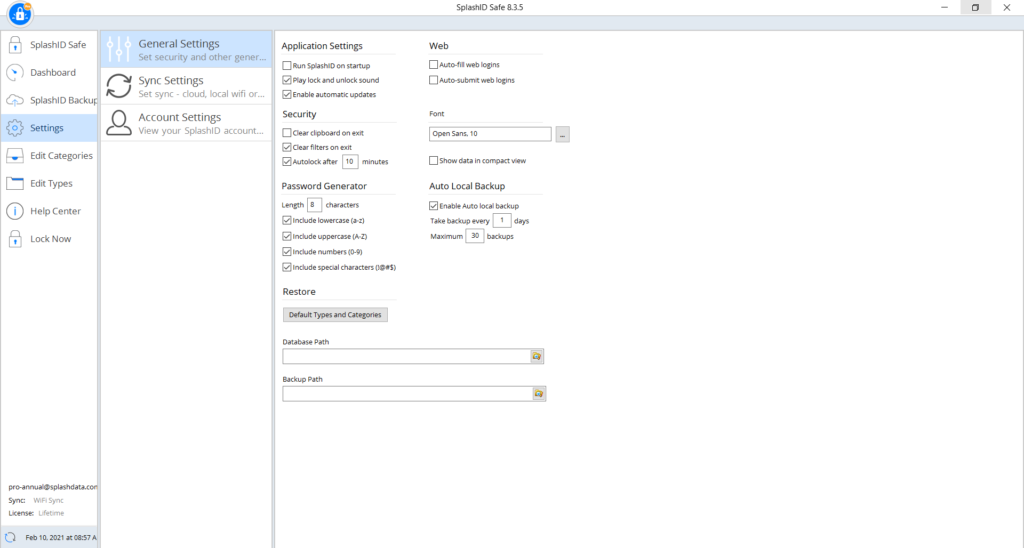
General settings for WiFi sync user
Application Settings
- Run SplashID on Startup – Automatically start SplashID when you log into your system or disable automatic startup.
- Play sound on Lock/Unlock – Turns on or off the “click” sound you hear at login.
- Enable automatic updates – Turn on automatic updates. Use this to switch on automatic update checking on app start. This will be required if you have previously disabled automatic update checking, and you want to re-enable the checking functionality.
Security
- Clear Clipboard – Instruct SplashID to clear copied text from your system’s clipboard on exit and/or after a specified number of minutes.
- Clear Filters on Exit – Resets the Type/Category filter settings to the default when you quit the app.
- Auto lock – Set the period of inactivity that must pass before the application locks itself.
Web Logins
- Auto-Fill Web Logins – Fill in username and password fields automatically.
- Auto-Submit Web Logins – Check this box to automatically submit forms when using the Web Auto-fill feature.
Font
- Change the main view font – Click the three dots icon to set or change the font, text size, font style.
- Show data in compact view – Shows more records in the main view without showing the 2nd or 3rd fields, or shows fewer records while showing 2nd/3rd fields of each record.
Auto Local Backup
If enabled, a VID backup file of your database will be exported in your SplashID data folder when the application is closed. The settings in this section allow you to set how often the local auto backup happens. The exported VID file created during the auto backup can be imported in case of a catastrophic loss of data. Your SplashID master password protects the backup files and will need to be provided when you import your records from these files. More details are available in the Backup & Restore section below.
Database Path & Backup Path
Allows you to change the Desktop app Database path location and/or Backups location. You can set or change these by clicking the icon on the right of the respective boxes. If the box is blank, that means the Desktop app does not have a custom location set and is using the default location(s).
Sync With Cloud
This is for Cloud sync users only. If for some reason the custom icons on your Windows app are not seen in the web application, you can perform full sync of the custom icons by clicking on the Custom Icons button in this section.
Restore
This is for WiFi sync and No sync users only. It allows you to restore the Default Types and Categories that came with SplashID when you first used it.
Sync Settings
This is where you select your sync settings for SplashID Desktop. Since SplashID 8, a SplashID Pro license is required for either of the three sync methods, Cloud or WiFi or No. You can choose and change at any time if you have a SplashID Pro license.
We’ll go into more detail in the Synchronization section below, but here you can select the sync method you want to use.
- SplashID Cloud Services – Seamless automatic sync using our secure cloud solution. It also enables the use of the Web app.
- Local WiFi sync only – Good old fashioned manual WiFi sync over your local WiFi network. Here you can also set the sync direction for the next WiFi sync.
- No Sync enabled – If you don’t need to sync data to any other devices or computers or with the cloud.
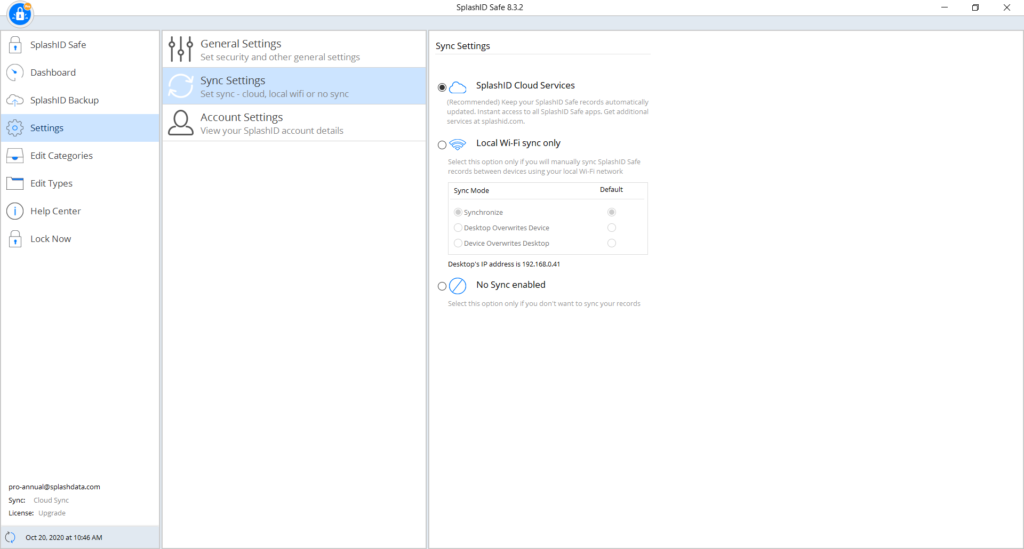
Account Settings
- Change Email – Click to change the email address associated with your SplashID account. After, a change you will need to verify the email address by clicking on a link in the verification email sent to the new address.
- Change Password – Click to edit the master password protecting your SplashID account. See Security for more info.
- Change Sync – Click to switch to a different sync solution.
- Plan – View your plan details and license status.
- Offline mode – It allows you to stop the desktop app from any communicating with our Cloud servers (requires at least 8.0.7 version of Windows desktop app). This feature is available for subscribed WiFi and No Sync users. With this mode enabled you can see all your records in offline mode, without needing SplashID to communicate with our servers. SplashID will ask you for permission to connect to the cloud if you wish to share records, change your master password, or if your subscription expires.
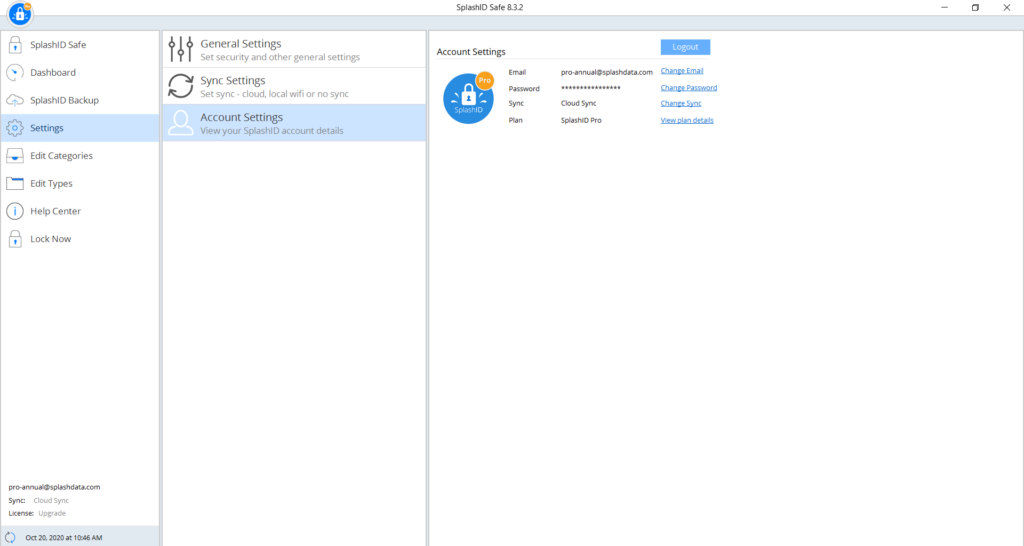
Account settings for a Cloud sync user
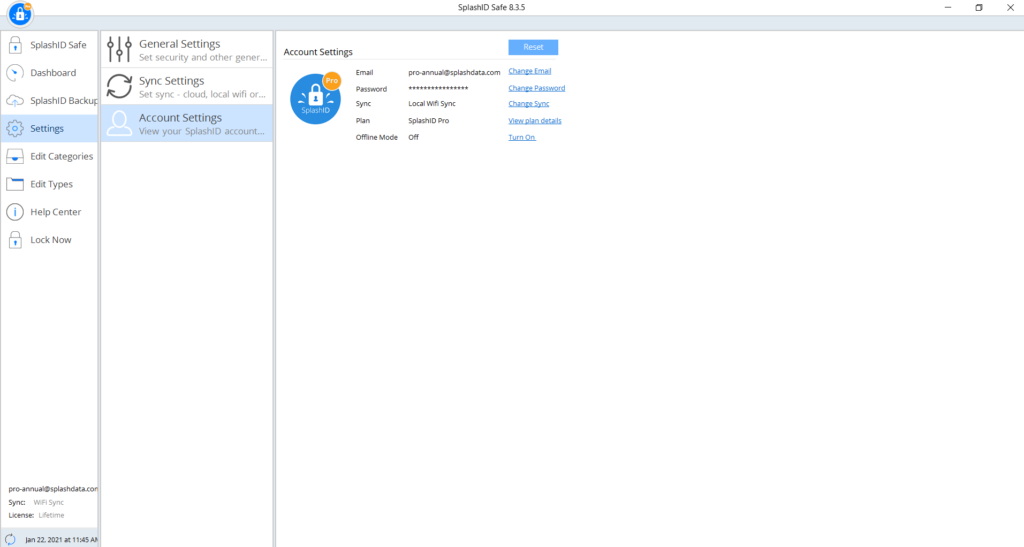
Account settings for a WiFi sync user
Logout for Cloud sync users and Reset for WiFi sync users allows them to clear the local database completely. This is useful when the user needs to ensure that their SplashID information is no longer stored locally. Once cleared the local database contents cannot be recovered. Use this option carefully.
Security
Setting a Password – You must set a master password to protect your data.
- Remember this password. You will need to use this same password to open SplashID on all the platforms you have SplashID – desktop, mobile apps, or the web app if using Cloud sync.
- Your password must be at least 4 characters in length.
- This password is case sensitive.
- A strong password of at least 8 characters including at least one number, one upper case character, and one non-alphanumeric character is strongly recommended.
- Once you set a password, SplashID encrypts your data using 256-bit Blowfish encryption to ensure data security.
- You can optionally enter a hint to remind you of your password if you forget or misplace it.
Setting a Pattern – This is more fun and a convenient way to login is using a pattern, though not as secure as using a strong master password. To set a pattern, click the Pattern button in the Set Password dialog. Then draw your pattern using the numbered dots supplied without any overlapping or repeating. Click Continue and confirm the pattern, then make a note of the numeric equivalent – this must match the SplashID desktop if you plan on synchronizing. Please note setting a pattern password will replace any text password. You cannot have both a text and a pattern password.
Entering a Password – You will be required to enter your password each time you launch SplashID desktop, or when you lock the Desktop app, or when it auto-locks according to the timeout set.
Changing a Password – To change your password, select Change Password from the Settings menu — Account Settings – enter your Old Password, then enter and confirm the New Password and optionally set a Hint.
2-Factor Authentication – 2-factor Authentication is a recommended option to increase the security of your SplashID account. The 2nd factor is an additional code that needs to be entered when your SplashID account is accessed from a new desktop, device, or web browser. Once you confirm, access is authorized with the additional code, and you will no longer need to enter the 2nd-factor code when you log in from that device or browser.
To use 2-Factor Authentication, login to your SplashID account at https://www.splashid.com/login using the Web client. Under Settings > 2-factor authentication, select ‘Enable 2-Factor Authentication’ and click on Save. Once enabled, if you attempt to log in to your SplashID account from a new web browser, desktop, tablet, or phone, you will be required to enter a 6-digit code that is emailed to your SplashID account email address or sent by SMS to your phone number. Once you enter the second-factor code, you will never be asked for the code again on that browser or device. If you want to authorize access on another new web browser or device, you will need another second-factor authorization code.
Sharing Records
You can share information with other SplashID users in a few different ways:
- Share Multiple Records – When in the List View, click the Select button on the top toolbar, and then choose records you wish to share. Then click the Share button on the bottom toolbar.
- Share Single Record – When viewing the Record Info, click the Share button on the bottom toolbar.
Synchronization
You have a choice between local WiFi sync and SplashID Cloud Services.
SplashID Cloud Services
Our cloud syncing service seamlessly updates any changes to your records when you launch the application. No more fussing with WiFi sync (unless you want to).
Here’s the great thing about it – we don’t have to explain how to use it. Just login to your various SplashID versions (iPhone, iPad, Mac, Windows, Android, and web app) with the same email address, and your data synchronizes automatically. Never is it out of sync, never do you have to worry about the loss of data or backing up. It just works.

Local WiFi Sync Only
This is the familiar WiFi sync solution that has been in SplashID since version 4. Manually connect the handheld and desktop apps over your local WiFi network.
Items may be created or edited on the mobile device or Desktop and the changes can be synchronized over your local WiFi network. You can download SplashID Desktop for Mac or Windows from https://www.splashid.com/downloads.
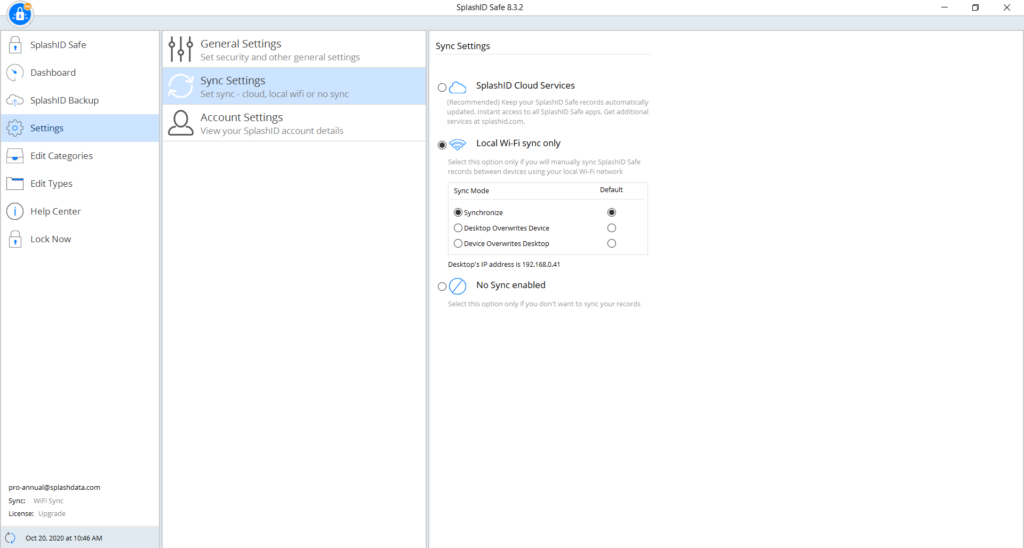
By default, information is synchronized in both directions, but you can adjust the settings, in Sync Settings which can be found in the Desktop app’s Settings.
In most cases, you will wish to leave the Default setting set to Synchronize. This means that after changing it to Desktop Overwrites Handheld and doing sync, it will revert back to Synchronize for the next sync so you don’t have to go back in and change the setting back manually.
Here are the possible sync settings and the results they will bring about:
- Synchronize – Changes made on the mobile device or the Desktop will be synchronized. If a record is edited on both sides between syncs, the latest edit will win.
- Desktop overwrites Device – All data on the Desktop is copied to the mobile device. Any data on the mobile device will be replaced.
- Device overwrites Desktop – All data on the mobile device is copied to the Desktop. Any data on the Desktop will be replaced.
In order to synchronize, you must do the following:
- Turn on WiFi on your handheld device, then select the same network that your computer is on for your handheld to join
- Open the SplashID Desktop, and make sure it is unlocked
- Make sure the Desktop app user name in the bottom left corner matches the user name in the mobile device app
- Adjust the Sync Settings in Settings > Sync Settings if you wish
- Start the Sync on the mobile device, by dragging down on the Record List with your finger, or tapping the “Last sync: date/time” button/label.
Manual IP Address Sync
If you have trouble connecting your mobile device and Desktop SplashID, you can sync using a manual IP address.
To do this, open the Sync dialog on the mobile device and click where it says Enter an IP Address “To sync with.”
Enter the IP address of the Desktop computer, either on the local network or the public IP if connected directly to the Internet. You can find this IP address in the SplashID Desktop under Settings > Sync Settings.
Backup & Restore
In version 8, we added an automatic cloud backup service that is available to Cloud Sync users.
Cloud Sync Users – SplashID Backup
With SplashID 8, cloud sync users have a new backup service that protects them from data loss forever. Every week, a new encrypted backup is automatically created for you. Your 5 most recent backups are available anytime to download or restore as your current database. And you can lock in any backup (or your current database) as your master backup.
Hopefully you’ll never need to use it, but if you do, here’s how to do it.
Login to any SplashID 8 client app – iOS, Android, Mac, or Windows – and select the SplashID Backup tab on the side menu.
To restore a backup, select the backup you would like to restore, based on the date and number of records it contains, and then click Restore.
You can also make your current database the “master” backup by clicking the blue button at the top of the screen. The master never gets overwritten by newer backups, giving you a reliable restore point once you set it. If you want to release the master backup, click the Unlock button. Or you can just replace the current master backup with your current database at any time by again clicking the blue button at the top of the screen.
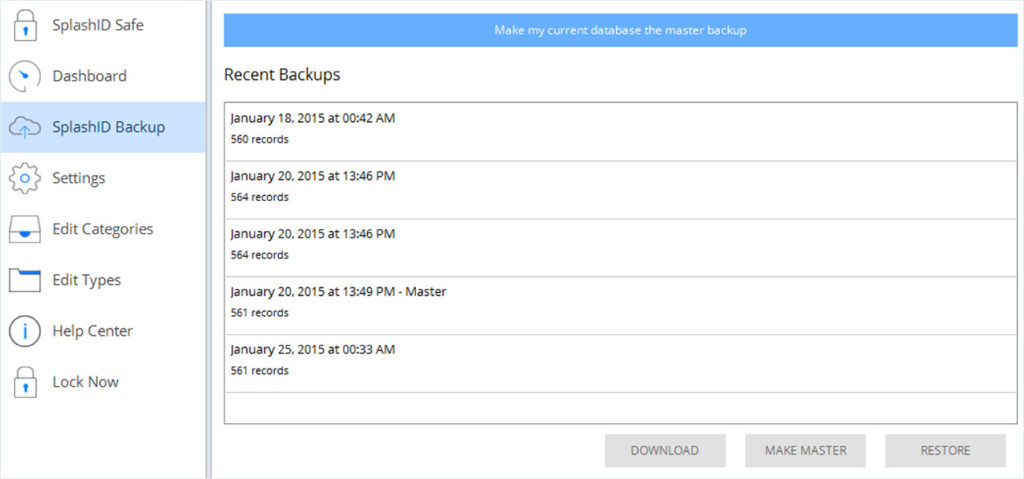
Manual SVID and vID Backups
You may also perform a manual backup of your data by selecting Export from the App menu. This will export your SplashID Database in SVID or vID format to whatever location you select. You will be given the option to set a password as well, which will encrypt the data and require the password to import it. We recommend you to use SVID files as it has enhanced information and your uploaded icons on records.
WiFi and No Sync users – Backup Options
Automatic vID Backups
/Documents/SplashData/SplashID.8/Backup/
Up to 5 backups will be saved incrementally. You can see which is most recent by the file date. If you later need to import this data, simply double-click the .vid file and you will be prompted for a password and the data will be imported into SplashID Desktop.
SplashID Desktop has an automatic backup feature that will allow you to easily recover data in most cases. A VID export file is created and encrypted with the same password you use in SplashID and stored in the location shown below.
You can also import it via the Import menu in the main Application menu.
Manual SVID and vID Backups
You may also perform a manual backup of your data by selecting Export from the App menu. This will export your SplashID Database in SVID or vID format to whatever location you select. You will be given the option to set a password as well, which will encrypt the data and require the password to import it. We recommend you to use SVID files as it has enhanced information and your uploaded icons on records.
Desktop
The SplashID Desktop database file is automatically saved to the SplashID directory on your hard drive each time you exit the Desktop application. You may back up this file as an added precaution in case of a hard drive failure. To restore the backup file simply copy it into the SplashID directory. Then the next time you launch SplashID Desktop it will open the file. This file is stored in the location shown below.
Documents/SplashData/SplashID.8/SplashIDDatabase.sdb
Dashboard
It seems like every day you hear about a new hacking incident or data breach, and you know you should be combing through your SplashID records, changing your old or weak passwords, and of course, making sure you’re not using the same passwords on multiple sites. That’s what you should be doing, but the task is too often put off since it can be time-consuming and overwhelming.
That’s where our new dashboard comes in, constantly analyzing your SplashID records to identify old, weak, and reused passwords and enabling you to fix them with just a few clicks!
The graph shows you the overall growth of your SplashID database over time, and under that, you will find a table indicating the total number of categories, types, and records in your database.
Below that you will find an analysis of how many of your passwords are Repeated, Weak, or Old. The progress indicator to the left shows how much of your database contains these weaknesses. Click the View and Fix button to access a list of the records that contain these weaknesses. The idea is that you take on one of these weak records, generate a stronger password in SplashID while login into the website and updating your password with the service.
At the bottom of the Dashboard screen is a handy shortcut to the SplashID Backup feature.
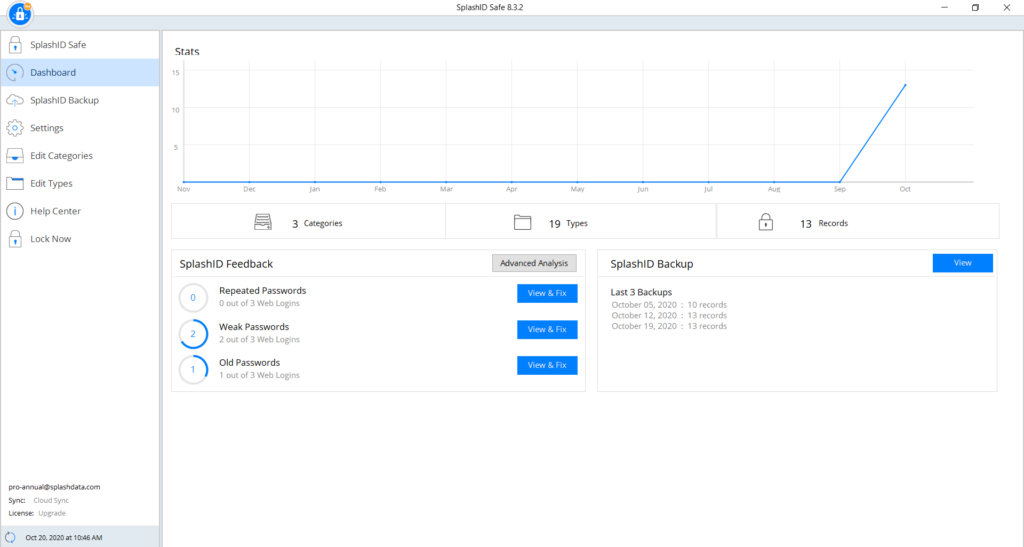
Other Features
Default browser
SplashID will open the web pages when you click on the Web Login button in the default browser for the system.
Check for update
The Check for update feature allows you to take a backup before updating SplashID.
Getting Support
SplashData offers technical support and other resources online. SplashID Safe support is customized to meet your needs. Please go to https://www.splashid.com/support to get help on an issue by our experts, or visit our support center at https://support.splashdata.com for useful information on commonly occurring issues that can be resolved by yourself.
At the support center you can view knowledge base articles, or contact customer support to get the answers you need.
App Updates
The Windows SplashID app is available at https://www.splashid.com/downloads for you to download and install.
The Check for update feature in the application menu allows you to check for new versions of SplashID when they get released.
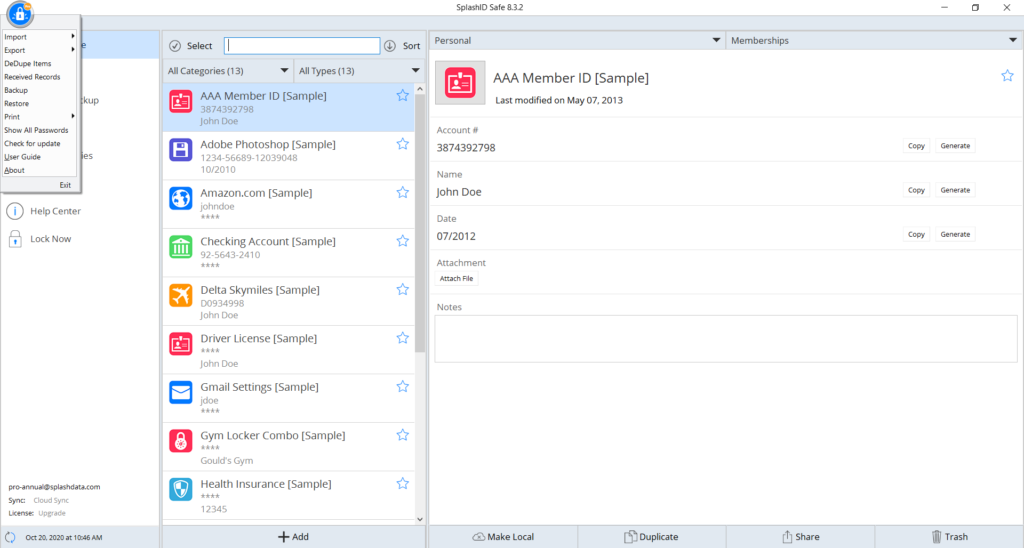
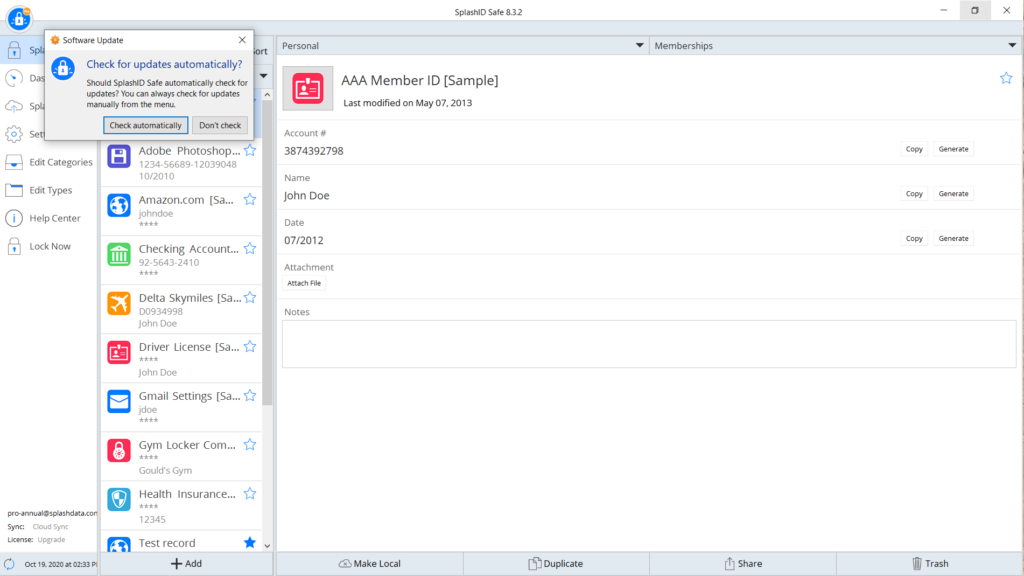
To study the release notes you can visit our page at https://www.splashid.com/release-notes.
